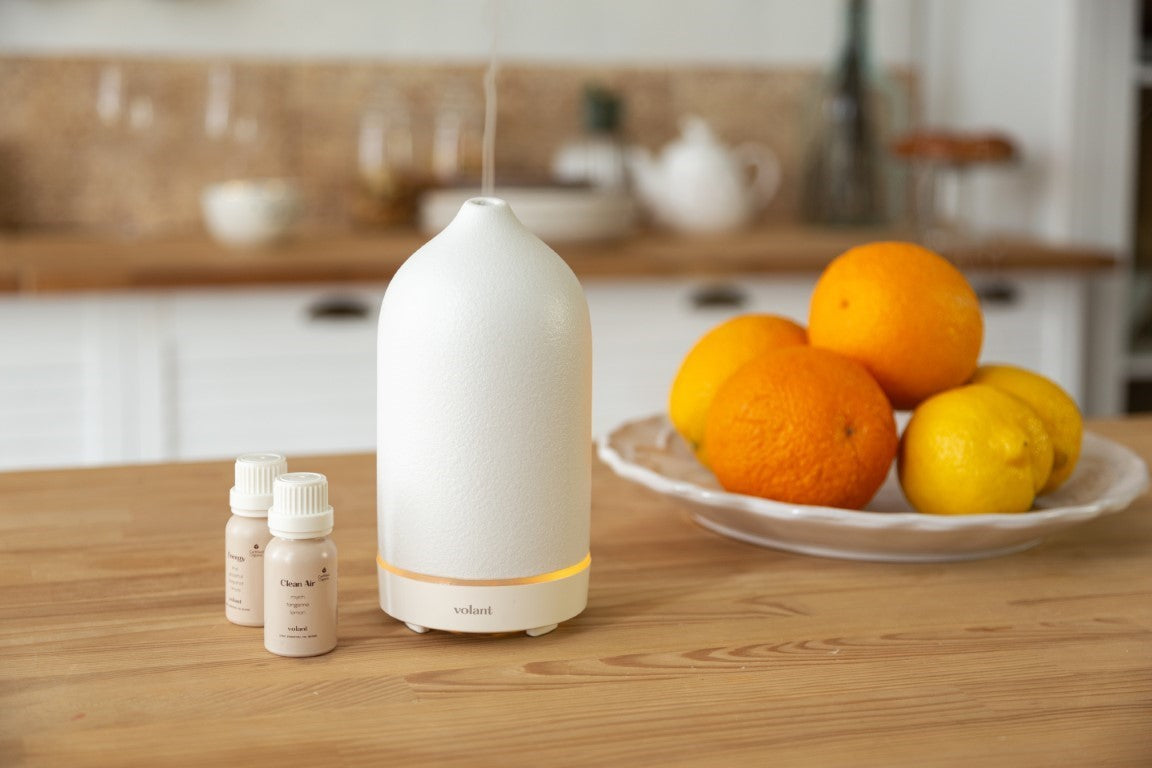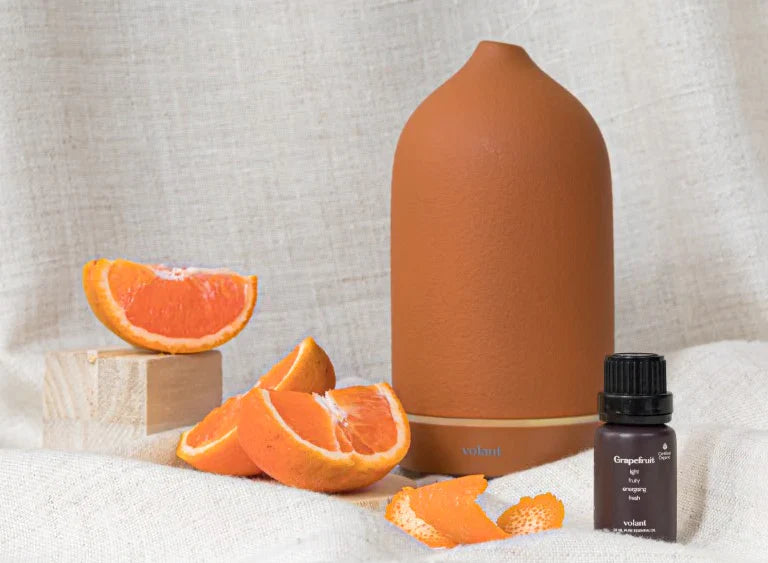If you fail to maintain your diffuser correctly, you could shorten the lifespan of your diffuser significantly, leading to an expensive repair bill, or even a replacement being necessary. Cleaning your diffuser regularly is the best way to keep it operating effectively.
But how do you practice proper diffuser maintenance and why is it so important? In this article, we will tell you everything you need to know about maintaining diffusers, helping you to get the most out of your essential oil diffuser.
Do you really need to clean your diffuser after every use?

You might notice that your diffuser instructions advise you to clean your diffuser after every use. This may seem a little bit excessive at first, especially if you plan to use it again tomorrow. You are probably wondering whether you really need to clean your diffuser every single time.
However, regularly cleaning your diffuser is essential for its efficient operation. If you don’t clean your diffuser according to the manufacturer instructions, you may find that your diffuser doesn’t work as efficiently, and its performance will begin to decline.
After each use, you should empty any remaining water and essential oils from the diffuser, wipe it with a clean cloth and ensure that it is thoroughly dry before replacing the lid and storing your diffuser. Once a month, you’ll need to give your diffuser a deep clean. This can be done either with or without vinegar, depending on your personal preferences.
So after each use of your diffuser, be sure to fully empty it of all water and oil and give it a good clean.
The benefits of diffuser maintenance
It can be easy to forget to clean your diffuser, especially if you use it regularly. It might seem like a tedious, unnecessary task, especially if you’re using it every day.
However, it is important to clean your diffuser after every use to keep it in the best possible condition. This will help to prevent blockages within the diffuser as well as ensure that the aroma of your oils remains pure.
Here are three definitive reasons to properly maintain your essential oil diffuser:
1. Prevent corrosion of diffuser
Certain essential oils such as lemongrass, citronella and oregano oil can be corrosive due to their high levels of acidity. If you leave them sitting in your diffuser after use, they can damage the diffuser. Emptying and cleaning your diffuser after every use will help to prevent corrosion, keeping your diffuser in full working order.
2. Prolong diffuser lifespan
It goes without saying that if you look after your diffuser, it will be less prone to breakdowns. This is because essential oils can quickly build up, causing blockages within the mechanisms of the diffuser. That’s why properly maintaining your diffuser according to the manufacturer’s instructions is so essential for prolonging the life of your diffuser.
3. Improve aroma of essential oils
Essential oils have a high viscosity, especially oils such as patchouli, rose, camomile and sandalwood. These oils are prone to leaving behind residue within your diffuser, even if you empty and refill it. These leftover residues will affect the scent of the next oil you diffuse, potentially impacting the benefits that you receive from that scent. For example, if you are diffusing relaxing lavender oil that is tainted by leftover uplifting grapefruit oil, it could make it more difficult for you to relax.
Top tips for keeping your diffuser healthy

Here are some of our top tips for getting the most out of your diffuser.
● Don’t overfill your diffuser with water. If you exceed the maximum fill line, your diffuser could overheat.
● Try to use distilled or purified water in your diffuser wherever possible. Tap water contains minerals that could build up in your diffuser, damaging the internal mechanisms.
● Only use pure essential oils, avoiding any additives or fillers. These can build up in your diffuser, causing long-term damage.
● Be sure to keep exterior buttons and air vents dry when emptying and filling the diffuser, as well as during the cleaning process.
● Avoid leaving water sitting in your diffuser for long periods of time. This can cause bacteria to grow, damaging your diffuser.
● Keep away from abrasive cleaners and solvents. Stick to natural products such as essential oils, distilled water and pure white vinegar.
How to clean a diffuser with vinegar step-by-step
We have already discussed why it is important to clean your essential oil diffuser regularly. But how exactly do you clean a diffuser? The most effective way to clean a diffuser is with vinegar. However, it’s important to ensure that you choose pure white vinegar for this.
Follow the simple steps below to clean your diffuser with vinegar.
1. Unplug and empty diffuser
First things first, make sure that you unplug your diffuser before you begin the cleaning process. Not only will this avoid any damage to your diffuser, but it will also help to keep you safe too. You’ll also need to empty it of any leftover water or essential oil that may remain in the reservoir.
2. Fill with water and vinegar solution
Next, add distilled water to your diffuser reservoir until it is around halfway full. Ensure that you don’t reach the max fill line in this step to avoid damage to your diffuser. Then, add ten drops of pure white vinegar to the reservoir. Whilst water is sufficient to remove particles from the interior, vinegar will help to remove any oil residue that remains on the walls.
3. Run your diffuser
Plug in your diffuser, turn it on and allow it to run for up to five minutes. This will allow the water and vinegar solution to flow through the diffuser and clear any residual oil from the internal mechanisms.
4. Drain diffuser
After the cleaning solution has been running through the diffuser for around five minutes, turn off the diffuser and unplug it. You can then drain the cleaning solution from the diffuser, leaving it empty.
5. Clean residue
If your diffuser came with a cleaning brush, this is where you’ll use it. Otherwise, a clean cotton swab can also be effective. Take your cleaning brush or cotton swab and dip it into pure white vinegar. This will help you to cut through any oil deposits that may still be lingering on your diffuser. Use the swab to clean the corners and tight spots within the diffuser, ensuring that all oil is removed.
6. Rinse and dry diffuser
Now that any residual oil has been removed from the diffuser, it’s time to wash away the vinegar. To do this, add distilled water to your diffuser and allow it to run through the diffuser for a few minutes. This will remove the vinegar, leaving your diffuser clean and fresh. You can then use a microfibre cloth to carefully dry your diffuser. Alternatively, you can allow your diffuser to air dry. Whichever method you choose, it’s important to ensure that your diffuser is fully dry before replacing the cover for storage.
7. Clean cover
Finally, you can move onto cleaning the exterior cover of your diffuser. It’s important to follow the manufacturer’s instructions here, as how you will clean the cover will depend on the material it is made from. For some diffusers, cleaning the exterior cover with a damp cloth will be sufficient, whilst others may permit a small amount of dishwashing detergent.

How to clean oil diffuser without vinegar
If you prefer to avoid using vinegar to clean your diffuser, there is another effective option. To follow this method, you’ll need a cotton swab, rubbing alcohol and a clean microfibre cloth.
Here are the simple steps to follow for cleaning your essential oil diffuser without vinegar.
1. Unplug and empty diffuser
Begin by unplugging your diffuser from the power supply and emptying any water and oil that remain in the reservoir.
2. Wipe the reservoir
Next, use a clean microfibre cloth to wipe around the inside of the diffuser reservoir, removing any remaining water and essential oils. After completing this step, the reservoir should be dry.
3. Clean away any residue
Then, take a clean cotton swab or the cleaning brush that came with your diffuser and dip it in rubbing alcohol or orange essential oil. Use the cotton swab to clean the interior of your diffuser, including the fan inlet and the ultrasonic plate. This should remove all traces of any leftover essential oils.
4. Run your diffuser
Next, top up your diffuser with distilled water and allow it to run for a few minutes. This will ensure that the rubbing alcohol is removed from your diffuser. After a few minutes, switch off the diffuser and empty out the remaining water.
5. Clean diffuser cover
Finally, clean the exterior cover of your diffuser. You’ll need to follow the manufacturer’s instructions for this, as different materials will require different cleaning techniques. Some diffusers will require you to only use a damp cloth, whilst others may permit a small amount of dishwashing detergent.
Troubleshooting your diffuser
Despite regular maintenance, sometimes you might find that your diffuser runs into problems or begins to operate below maximum efficiency. Cleaning is often the answer, but sometimes this might not solve the problem.
Here are some of the most common issues that people experience with diffusers, along with actionable steps you can take to resolve them.
1. Diffuser won’t power on
If your diffuser won’t power on, there are a few things you’ll need to check. Firstly, ensure that the power plug is connected to the electrical outlet and that the outlet is turned on. Then, ensure that the power supply is plugged into the diffuser itself.
You will also need to ensure that the reservoir contains the right amount of water, not exceeding the maximum fill line. If your diffuser still won’t power on, turn it off, empty it and wait a few days for it to fully dry out before trying again. This will enable any internal components the chance to dry out if they have become wet during cleaning or regular use.
2. Water overheats in diffuser
The most common cause of water overheating in a diffuser is often that it has been overfilled with water. If this is the case, you will need to turn off and unplug the diffuser from the power supply before emptying the water. Leave the diffuser to cool down completely before refilling to the correct level and trying again. If the diffuser won’t start after being emptied and cooled, it is likely to have been damaged by overfilling and will require repair or replacement.
If you find that the water in your diffuser is overheating without being overfilled, it’s likely that there is a problem with the fan intake. Ensure that the fan isn’t being obstructed by a towel or cloth and look for any hairs that may be stuck in it. Unplug the diffuser and allow it to cool before refilling and restarting.
3. Poor diffusion
If your diffuser is not as powerful as usual, or there is very little diffusion, there are a few things you will need to check. First, ensure there is enough water in your diffuser. If the water level is too low, it may be unable to operate. If there is enough water in your diffuser, the fan inlet may be blocked by dried essential oils. Try cleaning your diffuser with a clean cotton swab, then run a solution of distilled water and a few drops of pure white vinegar through your diffuser to clean the inlet and clear the blockage.
4. Indicator light flashes but diffuser does not start
If your diffuser doesn’t start despite the indicator light flashing, it’s likely that a fault has been detected or that the diffuser has malfunctioned. Unplug the diffuser, empty the water from the reservoir and allow it to cool down. When it has fully cooled, refill the reservoir and restart the diffuser. If the diffuser still fails to start, it will need to be professionally repaired or replaced.
To sum up
Essential oil diffusers serve a multitude of purposes, from invoking a sense of relaxation and calm to setting a particular atmosphere for guests to boosting your energy and giving you the motivation to get the most out of life. However, to achieve the maximum lifespan out of your diffuser, a little effort goes a long way in maintaining and cleaning your diffuser.
It’s always best to read the manufacturer’s instruction manual that came with your diffuser to ensure that you’re following the best practices for your individual diffuser. This includes cleaning your diffuser after each use and ensuring that you follow the instructions carefully to prevent damage from occurring.
Maintaining diffusers can be annoying and time-consuming, but it can help to prevent costly damage from occurring and prolong the life of your essential oil diffuser. With a little TLC and some regular maintenance, diffusers can offer you many years of delightful aromas and relaxing scents for your home.






